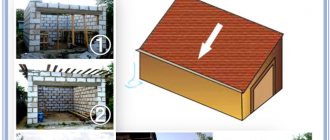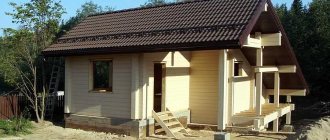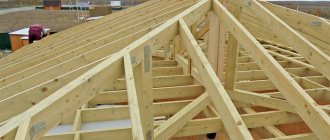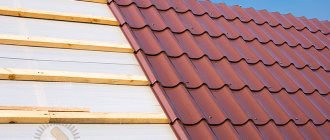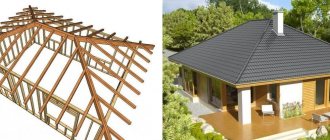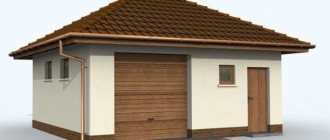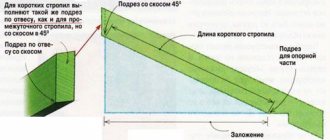A hip roof is a type of hip roof, in which two slopes are trapezoidal in shape, and the other two (end ones) are triangular (having the same name “hips”). If the end slopes occupy the entire area from the ridge to the eaves, it is a hip roof; if they do not reach the eaves, it is a half-hip roof.
The roof of a house performs a dual function - on the one hand, it is charged with protecting the building from external influences, and on the other, it is designed to decorate the structure and give it individuality.
Historically, in Russia preference was given to simpler single- and gable roofs, while Europeans prefer a hip or hip roof, which has advantages and disadvantages under certain conditions.
Hip roof - advantages and disadvantages
Pros:
- minimum resistance to wind load relative to a gable roof. Since all the slopes are inclined, the wind does not create destructive pressure on the gables;
- greater structural rigidity. Achieved by corner ribs connecting near the ridge support beam;
- the possibility of arranging more protruding overhangs, which provides additional protection for the walls of the house;
- aesthetic appeal.
Minuses:
- complexity of calculation and installation;
- higher cost of project implementation;
- reducing the area of the attic (in particular in the area where diagonal supports are installed);
- impossibility of installing an attic;
- natural light is only possible by installing windows in the roofing pie.
Since the shortcomings are not critical, the hip-type hip roof is actively practiced in modern construction of private houses.
What is slope, optimal slope angle values
The slope of the roof is an important determining factor of the structure, formed by the angle cut off by the floor plane and the roof slope. The indicator is expressed as a percentage or degrees, calculated by dividing the height of the ridge by 1/2 the width of the building. The angle of inclination of a metal tile roof is regulated by SNiP and the supplier’s instructions. The indicator depends on factors such as:
- Application of roof covering on the roof.
- The ability of a roof to effectively remove natural precipitation, resist winds and other climatic phenomena.
- Roofing price.
- The mass of the roofing cake.
A fairly new coating, metal tiles, is not so strictly regulated by standards. Therefore, the manufacturer himself often recommends the minimum angle indicator, based on the technical characteristics of the product. The calculation is made based on the thickness of the sheet, the load-bearing capacity of the base and the method of laying out the roofing. However, there are optimal values that you should rely on:
- With a slope of 6 meters in length, the minimum slope according to SNiP must be at least 14°.
- The permissible slope of a metal tile roof should be in the range of 14-45°.
- The optimal angle is 22°, this indicator is sufficient for normal sediment removal with a slope area of less than 6 meters.
Choosing a roof slope is not always simple, therefore, based on SNiP indicators, you should take into account the following recommendations for the slope slope being arranged:
- Level of snow load in the construction region. To determine the indicator, you need to take information from the directory and calculate the average annual amount in winter. The thicker the snow cover, the greater the level of slope, otherwise the snow mass will linger on the roof, which will lead to deformation of the sheets.
- Wind load - this indicator also depends on the characteristics of the region. At maximum intensity of wind flows, the angle of inclination is small, which reduces the windage of the slopes.
Advice! The number of hurricanes, tornadoes and other natural disasters is also taken into account. Information is taken from reference books.
Varieties (types and types) of hip roof
When studying the structure of the hip roof rafter system, it should be taken into account that within this type, there are several types of structures. In turn, this makes adjustments to the overall process of constructing the frame of the rafter system.
Classic hip roof
It is distinguished by the support of the diagonal ribs on the ridge support beam and the location of the overhangs at the same height. The individual elements of the hip roof correspond to a triangle (gables) and a trapezoid (slopes).
Diagram of the rafter system and the appearance of the hip roof (regular, standard)
Hip hip roof
It is distinguished by the absence of a ridge support beam. This leads to the fact that all the diagonal ribs converge at a single point, and ordinary short rafters are already adjacent to them. This type of roof is preferred if the house has a square frame. But forming a reliable ridge assembly is quite difficult.
Diagram of the rafter system and the appearance of the hipped hip roof
Half hip roof
It is distinguished by the presence of vertical gables in which windows can be installed. The picture shows the difference between two types of half-hip roofs (Dutch and Danish).
Diagram of the rafter system and the appearance of the Dutch hip roof
Diagram of the rafter system and the appearance of the Danish hip roof
Sloping hip roof or mansard hipped roof
The most complex design in terms of construction is the hip roof truss system, since in this case, all roof slopes have different areas and diverge at different angles. A sloping (attic) roof allows you to more rationally organize the internal roof space and, in addition to additional living space, give the house a spectacular appearance.
Diagram of the rafter system and the appearance of a sloping hip roof (mansard type)
How many degrees should the minimum angle have?
The minimum slope of a metal tile roof is 10 degrees. A slope is allowed that ranges from 10 to 90 degrees. When choosing the optimal slope angle, you need to take into account that at a small degree the space between the roof and the ceiling cannot be used for any economic purposes.
If the highest roof angle is set for metal tiles, then going onto the roof to carry out technical work will be very difficult. Moreover, the larger the angle, the higher the ridge is located and, accordingly, the area that needs to be covered increases.
Thus, more roofing materials will be needed, and this will affect the budget. In addition, the cost of roofing work will also increase.
When correctly calculating the roof slope angle for metal tiles, the calculator must take into account the following aspects:
Roof tile model
. It should be noted that most manufacturers indicate the minimum slope of a metal tile roof in the product description.
What type of roof
Planned: single or double slope.
How will the snow be removed
from the roof.
Having carried out all the calculations and taking into account the above points, provided that the length of the slope surface is 6 m.p., the minimum slope is set at 22 degrees. Naturally, this result is not indicated in the technical documentation. It is calculated by experienced craftsmen in the process of observing roofs already in use.
This might be interesting!
In the article at the following link, read about how a roof is made from corrugated sheets.
Hip roof design
Regardless of the type of roof, all types have the same elements of the hip roof rafter system:
The layout of the ridge beam in the hip roof rafter system; ridge support beam or ridge beam - used for a classic hip roof, serves as a load-bearing element to which diagonal rafters are attached;
Layout of the diagonal (side) rafter of the hip roofdiagonal rafter (side, edge, slant or corner rafter) - a longer rafter leg that is attached to the end of the ridge beam at an acute angle, forming one of the sides of the triangle;
The layout of the central rafter of a hip roof is the central rafter - boards of the same length, which are adjacent to the ridge beam and form the edges of the trapezoidal roof slope. Between them there are intermediate rafters;
The layout of the intermediate rafters of a hip roof: an intermediate or ordinary rafter - forms the plane of a trapezoidal slope, the distance between them determines the run of the rafter system;
Layout of a hip roof rack. A rack or short rafter is a structural element that is attached to a diagonal rafter, forming a triangular overhang and corner parts of trapezoids.
Hip roof calculation
The calculation of the hip roof truss system is carried out taking into account the following prerequisites:
- wind load in the region. The higher it is, the flatter the slope should be, and the stronger the entire structure. To level out strong winds, the central and diagonal rafters are made thicker;
- amount of precipitation. An inverse relationship is observed. The higher the amount of precipitation, the steeper the slope should be so that snow and rain do not create pressure on the rafter system;
- type of roofing material. Each type of roofing material puts forward its own requirements for the sheathing, and also has a certain weight. These factors must be taken into account at the design stage;
- the need for roof insulation. In this case, the installation pitch of the rafters is calculated taking into account the width of the thermal insulation material. In addition, the distance between the rafters depends on the type and section of the wood.
Table of parameters for the distance between rafters depending on the cross-section of the timber and type of wood
The calculation of roofing material is carried out using formulas taking into account the angle of inclination of the roof. The optimal roof slope for different types of roofing materials is shown in the table:
Table - roof angle depending on roofing material
Table - roof angle depending on the type of covering
The slope of the slope angle determines the position of the rafters. In turn, the position of the intermediate rafter is calculated as follows:
- first, a center line is applied to the top trim of the end wall;
- then half the thickness of the ridge beam is calculated, and the placement line of the first of the central intermediate rafters is drawn;
- then the end of the measuring rod is aligned with the placement line of the central intermediate rafter marked above;
- a line of the internal contour of the side wall is applied to the opposite end of the measuring rod;
- the resulting point is the position of the intermediate rafter.
The relationship between the length of the rafters and their position is calculated using a correction factor, the value of which depends on the angle of inclination of the roof slope. The length of the rafter leg is determined by multiplying the laying by the coefficient.
Material prepared for the website www.moydomik.net
Formulas for calculating a hip roof
| Ridge height |
| |
| Ridge beam length | The length of the house minus its width |
|
| Length of central rafters (trapezoid) | Formula for calculating the length of the central rafters | Pythagorean theorem |
| Length of ordinary rafters | Calculated similarly to the length of the central rafters | |
| Extending the rafters to form a frame overhang |
| |
| Angle of inclination of ordinary rafters | Formula for calculating the angle of inclination of ordinary rafters |
|
| Length of diagonal hip rafters | Formula for calculating the length of diagonal rafters |
|
| Narozhniki (short rafters) | First short rafter |
|
| Second short rafter | Scheme for calculating the 2nd short rafter of a hip roof | |
| Hip roof area | Formula for calculating the area of a hip roof |
|
How to calculate the area of a hip roof?
To know how much roofing material to buy, you need to know the total roof area.
To do this, you need to break the entire roof into its component simple geometric shapes and make calculations for each of them.
Calculation of hip roof area - formulas
Calculating the area of a hip roof allows you to determine in advance not only the costs of purchasing roofing materials and installation, but also to determine the requirements for materials, as well as the need for arrangement and the exact configuration of the sheathing.
What are the advantages of metal tiles
This material has a number of advantages:
Light weight metal tiles
. There are from five to seven kilograms per square meter. It is used to cover the roof, which has a complex structure. Thanks to its lightness, there is no need to reinforce the rafters. This roof does not load the walls and foundation.
Due to the ease of installation of roofing material and the absence of the need for special tools, the cost of work
installation is relatively low.
This roofing material comes in a wide range of colors.
, so you can choose any of them to suit the overall tone of the building.
The tiles are made from thin sheets of steel, the thickness of which is from 0.4 to 0.7 millimeters. Thanks to its profile, it can withstand heavy loads
.
is protected from corrosion
galvanized and a polymer protective layer applied to the surface.
The main advantages of the material are durability, low cost and aesthetic appearance.
Hip roof rafter system drawing
The result of the project development and calculations will be a diagram-drawing of the hip roof rafter system. There are no similar drawings that are ready for use without taking into account the features of a particular structure and the place where it was built.
You can develop a preliminary design yourself (a simple sketch will help determine the direction of the project). But, it is better to entrust the drawing to specialists or use special programs for calculations. It should be remembered that the more complex the roof structure, the more accurately you need to calculate the rafter system: configuration and materials. This will also affect the cost and duration of installation work.
The hip roof drawing must include an indication of the purpose of the material, its installation location and method of fastening. It is advisable to include the key components of the hip roof rafter system, for example, the connection of diagonal supports to the ridge beam or the installation of rafter legs on the mauerlat, in a separate drawing and describe them in more detail.
Drawing of a hip roof (sloping rafters with emphasis on two purlins)
Scheme of wooden layered rafters with emphasis on two purlins for a hip roof
Drawing of a hip roof rafter system with a bay window
Scheme with dimensions of the hip roof rafter system with a bay window
Having a schematic drawing will be a good help in the manufacture of blanks and subsequent installation of the roof.
Design of reference points for rafter slopes
The upper part of the slanted rafter leg rests against the ridge beam. The design features of the hip roof allow you to do this in several ways:
- If the roof structure has one ridge girder, then the slope rests on the ridge console.
- If the rafter system has two ridge purlins and ordinary rafters made of boards, then the slopes should rest on the truss, the base of which rests on the ridge purlins.
- If the design provides for the presence of two purlins, and the rafters are made of timber, then a hammer is used instead of a truss. This element is made from cutting boards more than 5 cm thick and connects ordinary rafters near the ridge.
Depending on the planting method, the upper part of the slope is trimmed. Diagonals can be fastened with nails, but reinforcement with twisted wire or a metal clamp is allowed.
In the lower part, the diagonal rafters of the hip roof, resting on the Mauerlat, are attached using metal brackets or corners directly to the Mauerlat or to a specially installed corner beam.
Tools for building a hip roof
The design of the roof and the methods for arranging the components determine the set of tools that should be prepared before starting work.
To work with wood you will need: a level, a hacksaw, a hammer, a tape measure, a marking cord, and a stapler.
To work with metal structures you will need an electric drill, a riveter, and cutting shears.
Tools and consumables must be prepared in advance, because... The complex installation of a hip roof rafter system requires a large number of cuts and installation of nails.
To simplify measurements and be able to make all parts the same size, craftsmen advise replacing the tape measure with a measuring rod. The measuring rod is made of plywood 50 mm wide, onto which the main dimensions are applied.
Houses with a bay window
A bay window often becomes not only a spectacular facade element, but also allows you to create a cozy and well-lit area in the living room, dining room or bedroom.
To cover the semicircular bay window protruding beyond the facade, hipped and conical structures are used, which are in perfect harmony with the hip roof.
The bay window often serves as a kind of “core” on which all the floors of the house are “strung,” as in the photo of this modern cottage with a cascading hip roof.
Hip roof material
The species and type of wood have a direct impact on the durability and reliability of the roofing structure. Craftsmen advise giving preference to lumber or pine. All workpieces require pre-treatment with fire retardants and antiseptics.
In addition to wood, you will need metal fasteners, nails, screws, and anchor bolts.
Note. When forming a hip rafter system on a wooden house, which can shrink, craftsmen advise using floating fasteners to connect the rafters to the mauerlat. This method compensates for the movement of the crowns during the natural shrinkage of a house made of timber or logs.
Sliding support for rafters (closed sliding mount)
Features of low-slope metal tile roofs
The lowest slope angle is 14°, but experienced roofers lay materials when calculating an angle of 10-14°. And to ensure the reliability of the roofing carpet and reduce the risk of leaks, the following actions are performed:
- The frequency of slats in the sheathing increases due to the reduction in the inter-rafter pitch.
- The rafter system is strengthened by frequent or continuous lathing.
- Significantly increase the number of overlaps! Despite manufacturers' recommendations for a horizontal overlap of 8 cm and a vertical overlap of 10-15 cm, the overlap increases by the width of the wave. Thanks to this method, the strength of the roofing carpet is increased and the risk of leaks on the roof of a small slope is eliminated.
- Carefully seal the joints with silicone-based sealant.
Advice! All measures taken are temporary, so a visual inspection of the roof once a year will not hurt.
Hip roof rafter system - installation technology
DIY rafter system devices step by step:
Preparation of blanks (rafters)
This is the most difficult and time-consuming part of construction, because... associated with:
- the need to ensure a given angle of inclination of the rafter legs;
- different lengths of rafters (short rafters);
- the presence of diagonal rafters (sloping), which receive special attention. Due to their length, slanted rafters carry a greater load than the main rafters, and therefore require the use of higher quality lumber with a larger cross-section. In addition, often the length of the diagonal rafters exceeds the standard length of the boards.
In order not to buy different lumber, in practice the method of splicing (pairing) edged boards is used to obtain a given length.
Advantages of rafter splicing technology:
- obtaining continuous beams of a given length;
- increasing the strength of the diagonal rafters of the hip roof due to the doubled cross-section;
- simplification of calculation and purchase of material (unification of dimensions: length and cross-section);
- the possibility of using boards designed to form ordinary rafters.
Composite rafters made from boards with liners
Mounting the Mauerlat
The Mauerlat for a hip roof is a wooden beam of large cross-section (100x100 or 100x150 mm) mounted around the perimeter of the walls. First grade wood is used for the Mauerlat.
The peculiarity of laying the Mauerlat is that the timber is connected along the length only with an overlap, but not end-to-end, using many connection points with the base of the wall. The connecting nodes are additionally reinforced with metal brackets.
How to connect mauerlat bars for a hip roof
Since the purpose of the Mauerlat is to serve as a support for the rafter legs, it needs protection from moisture. For this purpose, a hydraulic barrier is placed between the wall and the beam (for example, roofing felt is used).
Note. Under the mauerlat in brick houses (or made of aerated concrete, foam concrete, wood concrete), a reinforced concrete belt with pre-installed studs for mounting the timber is poured. The pin has a diameter of 10 mm or more and should protrude beyond the plane of the Mauerlat by 20-30 mm. The stud installation pitch is 1000-1200 mm.
Purlin installation
A purlin is a beam installed parallel to the sides of the mauerlat. The purlin serves as the basis for installing additional supports under the rafter legs. The installation of a purlin is not a mandatory stage of work and is performed only for hip roofs of a large area or those with a configuration of increased complexity. The location of the purlin is shown in the diagram.
It should be taken into account that the point of maximum load will differ depending on the location - on the ridge of the hip or on the edge of the valley.
Points of maximum load on the hip ridge and valley ridge
Note. The hipped hip roof is mounted without support, and a complex assembly is formed at the junction of the diagonal rafters.
Installation of support posts
Hip roof support postThe posts serve as a support when installing the ridge beam (orange color in the picture).
Installation of a ridge beam
Installation of the hip roof ridge is accompanied by precise measurements. Since the entire roof structure will rest on the ridge, the correctness of its installation is checked in terms of height and level.
Fastening rafter legs
Regarding the sequence of work at this stage, the opinions of the craftsmen differ. This makes it possible to distinguish two directions for performing work:
- The central rafters are mounted, and then the diagonal ones. This procedure is simpler;
- diagonal rafters are mounted, and then the rest.
During installation, the lower part of the rafter leg rests on the Mauerlat.
The support of rafters on a hip roof is shown in the diagram. The first option (with a cutout) is simpler, but the second (with a support beam) is preferable, because in this case, the fastening does not weaken the rafter.
Methods for attaching rafters to the Mauerlat
Forming a knot on a ridge beam is possible in different ways.
Methods for attaching rafters to a ridge beam
Options for top fastening of diagonal rafters are shown in the diagram.
Methods for top support of diagonal rafters
Advice. For rigidity, it is advisable to reinforce all nodes with metal elements (staples, plates, corners).
Since diagonal rafters bear a significant load, they can be strengthened using such means as:
- installation of the rack. Mounted vertically on the ceiling;
- installation of the strut. Mounted at an angle. The angle of inclination is not decisive. The ability of the brace to strengthen the diagonal rafter is important;
- truss Essentially, this is a T-shaped short beam rotated 180°. It is used on long spans and is installed so that its base is oriented perpendicular to the diagonal rafter.
Hip roof truss support
Installation of ordinary rafters
The rows are installed similarly to the installation of the central rafters, which form the edges of the trapezoid. Their lower part rests and is attached to the mauerlat, and the upper part rests against the ridge beam. It is important to maintain the same distance between row rafters.
Installation of rafters (short rafters)
Spawners are made only from solid lumber. At the junction of the spigot and the long rafter, notches are made or support beams are installed. The installation site is additionally reinforced with metal elements.
Note. Installation of hip roof extensions is possible in staggered intervals to simplify installation.
Layout of hip roof rafters and installation of roof racks
In any case, the frames are installed after the roof’s load-bearing frame has been formed. Their installation completes the work on installing the hip roof rafter system.
What is slope
The roof slope is the angle formed between the roofing material and the ceiling.
Roof slope and roofing material
In documents it is indicated as a percentage or degrees. It is calculated by mathematically dividing the distance from the highest point at the intersection of the rafters, which is called the ridge, by one-half of the entire width of the building. The slope of the roof depends on:
what material
the building will be covered;
frame design
roof and its main parts;
how much the roof can withstand
atmospheric phenomena;
price
works of master roofers;
weight
all layers used.
On a note!
If the slope of a metal roof is changed from 22 to 45 degrees, the slope will increase by 20%. And this will significantly affect the cost of roofing materials, as well as the weight of the entire structure. In this case, the slope must be determined during the design of the entire building in order to have an idea of the load on the foundation.
DIY hip roof step by step - video
The program shows the process of installing a rafter system for a gable hip roof with a central bay window along a short wall.
Once the rafter system is ready, you can begin installing the roofing covering, the specifics of its fastening determine the need to install the sheathing on the rafter legs.
Installation of a hip roof truss system is a long process that requires attention to every stage of the work - from calculation and selection of material, to installation of parts and strengthening of fastening points. But, if all stages are carried out correctly, the result will be a beautiful and reliable roof for a private home.
Selection of roofing material
When choosing a roofing material, you should simultaneously take into account such parameters as strength, durability, and the absence of a corrosive component. According to professionals, seam roofing, corrugated sheeting and metal tiles have the best performance in these parameters.
Any question about using the calculator to calculate the parameters of a hip roof can be asked to our consultant by phone. An experienced specialist is always in touch and will be able to answer any technical question regarding the use of the calculator and the purchase of roofing materials.
